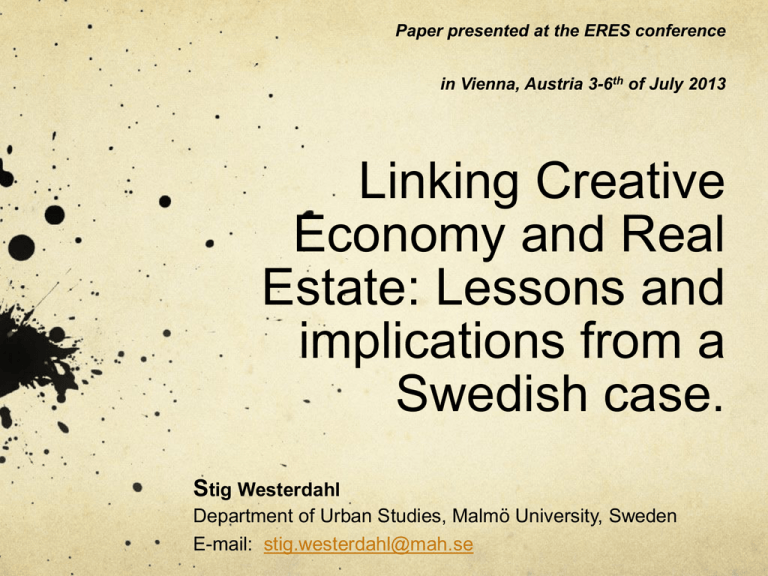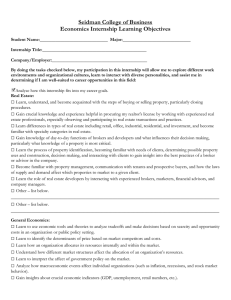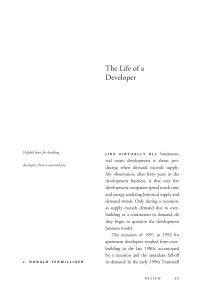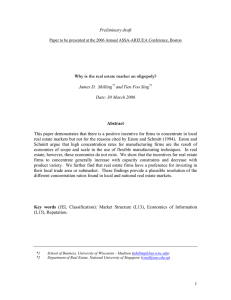Paper presented at the ERES conference in Vienna, Austria 3
advertisement

Paper presented at the ERES conference in Vienna, Austria 3-6th of July 2013 Linking Creative Economy and Real Estate: Lessons and implications from a Swedish case. Stig Westerdahl Department of Urban Studies, Malmö University, Sweden E-mail: stig.westerdahl@mah.se A Creative Economy? A Cultural or Creative Economy on the rise. Always existed as a sector or industry – now seen as a driver for the whole society. Essential part of city renewals – spectacular buildings. Opera House in Sidney Guggenheim in Bilbao Implications for Real Estate Industry and research? Outline Creative industry – define or characterise? Definition – a tricky issue. Several international attempts and suggestions for statistical classification. Examples: arts and crafts, audiovisuals, books, design work, films, music, new media, printed media, visual and performing arts, and creative services. Characteristics: Micro-enterprises (a few large actors) Usually project-based High risks Low initial costs Low transport costs The creative industry and the urban bias Short historical outline Experience industry (Pine & Gilmore 1999) A production system (Pratt 1997) Policy for creative industry – UK in the 1980’s. Other countries followed (Australia, Sweden with others). The general belief is how Creative industry is growing It is important to the entire economy Serves as an inspiration to other sectors. An urban bias is established. From production to consumption Richard Florida and his writings: Place Creative class: scientists and engineers, university professors, poets and architects, people in music, design, arts, entertainment and education. Health professionals and business managers.(30% of American workforce). 3 T’s: Talent, Tolerance and Technology Many critics. Large impact in policy circles – manifested also in inititives (and buildings) Competition and place marketing Connections to the real estate sector. From production (previous slide) to consumption. Creativity and urban change Jane Jacobs ”The Death and Life of Great American Cities”: “intricate sidewalk ballet”. Not much on gentrification or real estate companies. Zukin (1989) on “Loft Living” and (2009) on authenticity. De-industrialisation Empty production space became Lofts for artists When filled with Cultural capital: property developers take over Coincides with changes in the Art World: Galleries. Production out – consumption in. Pratt (2009) on Hoxton, London: A similar story. Where are the policies to make use of creative industry – no major effects from new residential housing. Currid (2007) on New York: “The Warhol Economy”. Fashion/art/music much more important that realised. Need for conscious political efforts. The meeting places crucial to creative industry. The joint view: Passive policymakers – and the property developers as culprits. They ripe the fruits, when artists have infused the cultural capital. The case: Färgfabriken Norr In the middle of Sweden – 600 km north of Stockholm Östersund - small town – 30.000 people. Sparsely populated region of Jämtland. Closure of regimental garrisons An Art Hall ”Färgfabriken Norr” opened 2008 in one of the former military buildings. Three year EU-funded project – to merge art with trade&industry. More jobs in an area suffering from loss of employment The property developers offered free rent for three years and renovation/adjustment of the premises. No proper calculations: ”gut feeling” and ”intuition” Property developers more committed than the public sector: Create an attractive area for industrial and residential tenants. Conclusions Östersund-case Focus on ”consumption” – less on ”production” Gut-feeling and intution rather than calculations. The overall situation of the area the main issue. Real estate industry at large: Tension ”Consumption” vs ”Production” of creative products/services point to Long term perspective necessary – compare London & New York studies (Zukin, Pratt, Currid and others). Values of mixed use underestimated? ”Gut-feeling and intuition” – Values of co-operation with the creative sector underestimated? Alternative management methods, see things in a new light? Important for a conservative industry such as real estate? The final conclusion Many question-marks!We know little on the role of property developers – in spite of research on Planning Creative industry and its importance at large The logics of art economy as opposed to financial economy. Social consequences of gentrification And the many disciplines involved: Human geography, economics, management, planning, humanities and others.. What about the real estate science? Future research needs to take property developers as point of departure: o Linkages property developers and financial institutions in urban development. o Linkages developers and public agencies: the role of creative industries? o Connections real estate sector and the creative sector – possible cooperation projects? Is a longer time horizon possible? o Are there openings for a rapprochement between real estate and the creative sector – beyond mere purchasing the products? What can the industry learn from the creative sector? Thanks for listening! Questions and comments welcome!











